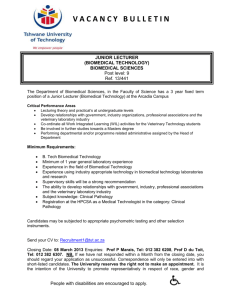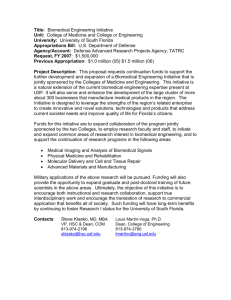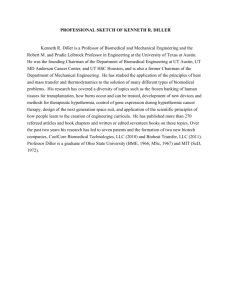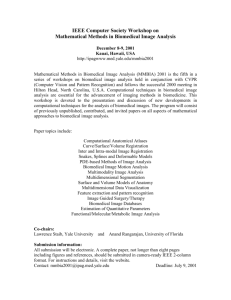生醫系統整合實驗室 Integrated Biomedical System Laboratory
advertisement
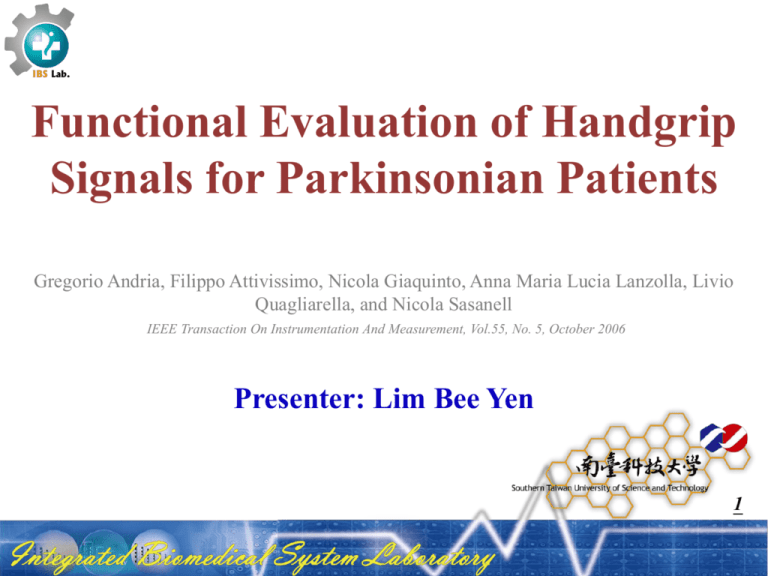
Functional Evaluation of Handgrip Signals for Parkinsonian Patients Gregorio Andria, Filippo Attivissimo, Nicola Giaquinto, Anna Maria Lucia Lanzolla, Livio Quagliarella, and Nicola Sasanell IEEE Transaction On Instrumentation And Measurement, Vol.55, No. 5, October 2006 Presenter: Lim Bee Yen 1 Outline Introduction of Parkinson’s disease Purposes Measurement System Factors Affecting Grip Strength: A review Experimental Tests Results Discussion and Conclusions 2 生醫系統整合實驗室 Integrated Biomedical System Laboratory Introduction of Parkinson’s disease Degenerative Diseases of the Nervous System Chronic neurological conditions associated with progressive loss of neurons. • No evidence of inflammation. • No evidence of cellular necrosis. Examples: • Alzheimer’s disease. • Parkinson’s disease. • Motor neuron disease (ALS). 3 生醫系統整合實驗室 Integrated Biomedical System Laboratory Parkinson’s disease(1/3) 2nd most common neurodegenerative disease. Mean onset = 57 years of age. Affects 1-2% of population over 60 years of age. Etiology is unknown. Disease progression is highly variable. Can be early onset in some cases. 4 生醫系統整合實驗室 Integrated Biomedical System Laboratory Parkinson’s disease(2/3) Patient’s afflicted with Parkinson’s disease are described as exhibiting a ‘classic triad’: – Resting tremor – Muscle rigidity – Bradykinesia Electroencephalograms (EEGs) record some aspects of brain electrical activity – not effective in spotting Parkinson’s disease No diagnostic test that can confirm Parkinson’s disease 生醫系統整合實驗室 Integrated Biomedical System Laboratory 5 Parkinson’s disease(3/3) Many studies concern gait analysis in Parkinsonian patients – high-cost equipment – problematic test protocols – experienced operators Simpler procedures have been used to analyze reach-to-grasp movements and ballistic movements with the upper limbs – high degrees of freedom and the complexity of the analyzed movements 6 生醫系統整合實驗室 Integrated Biomedical System Laboratory Purposes Measurement System A very simple and versatile system Able to perform most of the tests indispensable to hand functionality analysis Two main parts: – A handle – An acquisition system 7 生醫系統整合實驗室 Integrated Biomedical System Laboratory A handle Sensor based on traction Compression load cells – TCLZ-100KA-Tokyo Sokki Kenkyujo Company, supply voltage: 5 V, full scale 100 kg in order to measure the grip strength Rendering of the realized prototype equipped with accessories for different grasp typologies Prototype realized by Sezione di Ingegneria Biomedica—Università di Bari, Bari, Italy, in collaboration with the Measurement Group, Polytechnic of Bari. 生醫系統整合實驗室 Integrated Biomedical System Laboratory 8 An acquisition system Multichannel strain gauge conditioner and amplifier system: • Vishay M-M 2100 and 12-bit DAQ Board: PCL-718 Advantech for IBM Equipped with management and elaboration software to permit the complete characterization of hand motor activities. Both the young and the elderly, and the healthy and pathological people can easily use it. 9 生醫系統整合實驗室 Integrated Biomedical System Laboratory A standard calibration procedure A progression of known weights Varying in the range of 5–55 kg A step of 5 kg and applied in ascending and descending orders Suspended from the handle device, maintaining it in the vertical side The calibration cycle has been repeated three times For each applied weight, the handle extension has been measured 10 生醫系統整合實驗室 Integrated Biomedical System Laboratory A standard calibration procedure Relationship between the applied weights and the recorded strain of the handle of the developed measurement instrument 生醫系統整合實驗室 Integrated Biomedical System Laboratory 11 Factors affecting grip strength: A review(1/3) Effects of Body Position A standardized testing body position is important to compare different test results “The patient seated with his shoulder adducted and neutrally rotated, the elbow flexed at 90◦, and the forearm and wrist in neutral position.” -ASHT Effects of Multiple Trials Motor performances and the greatest grip strength usually occur in the earlier trials Fatigue does not affect the hand strength measurements 12 生醫系統整合實驗室 Integrated Biomedical System Laboratory Factors affecting grip strength: A review (2/3) Effects of Duration of Contraction Time Isometric contraction can cause potentially dangerous increases in blood pressure and pulse rate A duration of contraction phase equal to or less than 3 s is recommended Effects of Age Age is an important variable in the measurement of grip strength Grip strength has a nonlinear relationship to age(6~19, 20~50) Effects of Sex The hand strength of males is stronger than females In the range of 14–20 years, the differences between males and females increase rapidly 生醫系統整合實驗室 Integrated Biomedical System Laboratory 13 Factors affecting grip strength: A review(3/3) Effects of Hand Dominance Some have found that the grip strength of a dominant hand is approximately 10% greater than that of the nondominant Effects of Body Weight and Height There is a positive relationship between hand strength and the variables of weight and height Grip strength has a nonlinear relationship to age(6~19, 20~50) 14 生醫系統整合實驗室 Integrated Biomedical System Laboratory Experimental Tests (1/5) 44 people: 20 are healthy(11 men and nine women, averaging in age of 61 ± 4 years) 24 are pathological (15 men and nine women, averaging in age of 68 ± 6 years) Standard body position: Modified the standard body position described because for some Parkinsonian patients were not able to maintain the elbow flexed at 90∘ The proposed protocol is simple to understand, not requiring complicated adjustments of the subject position. 15 生醫系統整合實驗室 Integrated Biomedical System Laboratory Experimental Tests (2/5) Analysis: Using the Stokes suggestions to eliminate the trials that are suspected as fictitious loss of grip. Five successive trials: For each patient and for both hands, five successive trials have been carried out, recoding the relevant score every time. The procedure of test requests an initial contraction, which takes about 3 s , and a successive release phase. The global time duration of each trial is 6 s. 16 生醫系統整合實驗室 Integrated Biomedical System Laboratory Experimental Tests (3/5) Beginning and end of the test: Two different sounds identified the beginning and end of the test. When the patient heard the first sound, he should exercise the maximum strength on the handle, keeping the grasp until the perception of the second sound. A suitable acquisition system: IBM PLC-718 with an accuracy of 0.01% reading ± 1 bit) that uses a sampling frequency = 110 Hz. The obtained signal can be divided into five main phases [4]: reaction, contraction, maintenance, release, and relaxation 17 生醫系統整合實驗室 Integrated Biomedical System Laboratory Experimental Tests (4/5) Signal relevant to the healthy patient test Signal relevant to the Parkinsonian patient test 18 生醫系統整合實驗室 Integrated Biomedical System Laboratory Experimental Tests (5/5) Signal relevant to Parkinsonian patients (continuous line) and the relative filtered signal (circle marker). Filtered signal relevant to Parkinsonian patients (continuous line), the relative derivative signal (dotted line), and the relative area signal (dashed line). 19 生醫系統整合實驗室 Integrated Biomedical System Laboratory Results (1/3) No differences of sex and age were considered because our sample of patients was characterized by individuals aged over 50 years old. The parameters that high-light in a clear way meaningful differences between healthy and Parkinsonian patients were “fall speed” and “area signal.” The release phase is less fatiguing and less difficult with respect to the contraction one. 20 生醫系統整合實驗室 Integrated Biomedical System Laboratory Results (2/3) The area parameter takes into account all the main char- acteristics of grip strength behavior (contraction phase, maximum strength, and release phase). The velocities (in the rise and fall phase) represent the ratio between strength variation and time variation, giving information about the dynamics of the analyzed phenomena. 21 生醫系統整合實驗室 Integrated Biomedical System Laboratory Results (3/3) Fall speed values relevant to the Parkinsonian (continuous line) and healthy (line with the plus marker) patients with relative average values and standard uncertainty. Area signal values relevant to the Parkinsonian (continuous line) and healthy (line with plus marker) patients with relative average values and standard uncertainty. 生醫系統整合實驗室 Integrated Biomedical System Laboratory 22 Conclusions The applicability of a new analysis method for characterization of the motor activities of limbs has been investigated. Objective evaluation relevant to Parkinson’s disease and represents the first attempt to identify some criteria for estimating the impairment produced by Parkinson’s disease. The analysis concerns patients under treatment ON-state so that a confirmation of the results must be given by the tests made on the Parkinsonian patients in OFF-state. 23 生醫系統整合實驗室 Integrated Biomedical System Laboratory Thank you for your attention! http://faculty.stust.edu.tw/~terrydu/ 生醫系統整合實驗室 Integrated Biomedical System Laboratory 24


